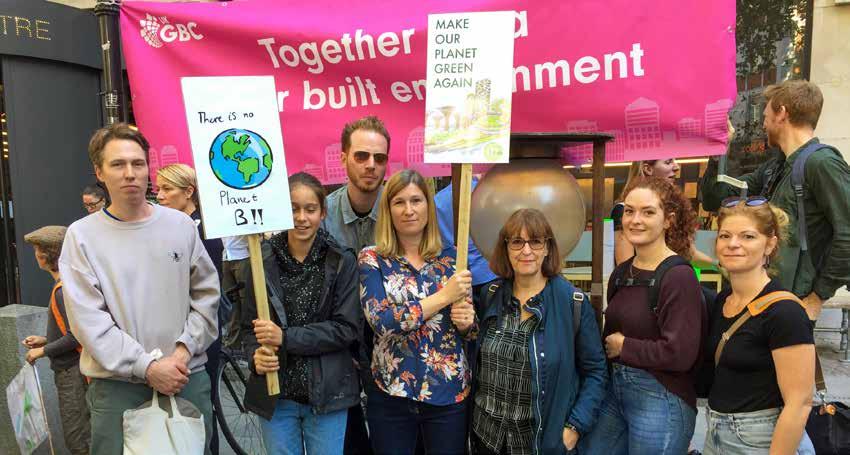
3 minute read
Addressing the Climate Emergency: Anna French
We asked four practitioners and commentators to explain what they thought landscape and other built environment professionals should do next to address climate emergency.

Global Strike for Climate on 20 September
© Anna French
Anna French
As landscape architects, we believe the work we do makes a difference. But I think we also know, deep down, that we’ve been fighting a losing battle. Trees that shouldn’t be cut down are felled, wild plants and habitats are sacrificed for profit and money spent on glass and concrete always takes priority over anything green. Our best laid plans are squeezed, watered down, never implemented or poorly maintained. But we are such optimists that we always imagine that one day people will wake up to how important our work is.
We probably also took note of the Paris Agreement and breathed a tentative sigh of relief when it was signed back in 2015. Yet somehow, inexplicably, we have let this catastrophe unfold. And while we’ve been busy studying, working and raising our children, the sands were running through the hourglass.
When I heard Greta Thunberg speak at the UN earlier this year, I had a feeling that this was the wake-up call. I took my daughters to the Global Climate Strike in March and was chastened by the urgency and power of the young people’s message. The more I read up on climate change, the more the extent of the damage became clear.
Now we understand that it has already gone so far and with such pace that there is a possibility that we will not get through this with our civilisation intact. Prof. Will Steffen explains reductions pathways. “Next realistic chance to peak global emissions is 2020. Then we can still hit the 2°C but we’ve got to get out of carbon by 2040. But if we delay to 2025: Impossible! You’d have to totally decarbonise in one decade.” 1 Whatever the outcome, as the effects of climate change take hold, we may grasp for any solutions that are about us. It is more crucial than ever for landscape architects to make sure our ideas are on the table.
We need to get clued up on water management, soil carbon storage, rewilding and permaculture. We need to preserve what biodiversity is left, restore peatlands and wetlands and design out urban heating. We need to learn to calculate the carbon footprints of our projects. We need to work out what ideas are important and what can be discarded. Electronic play equipment, and interactive displays are being installed with no thought about the impact. Electric cars will be part of the solution, but we cannot just switch all the petrol cars on the planet without causing another resource crisis. Public transport, walking and cycling are the future. Private luxury needs to give way to public enjoyment, we can imagine a more sociable, shared future where parks and amenity spaces are given much greater priority, rather than everyone obsessing over their own small patch.
Is runaway climate change the end result of runaway capitalism and colonialism? The youth climate movement certainly seems to think so. As Greta Thunberg said in her recent speech to the United Nations: ‘Entire ecosystems are collapsing. We are in the beginning of a mass extinction, and all you can talk about is money and fairy tales of eternal economic growth.’ So perhaps we also need to review our business models and consider a future of social enterprise, not solely focussed on profit.
Landscape architects are well placed to help but first we need governments of the world to get a grip of the problem. In their paper “Why Civil Resistance Works, The Strategic Logic of Nonviolent Conflict” 2 , Erica Chenoweth and Maria J. Stephan argue that once over 3.5% of a population become actively involved in non-violent civil disobedience, it is likely to tip the government to take action.
I set up Landscape for Future as a social media campaign in March to help get the message out to my landscape companions. Since then we have formed into a small group and along with many other landscape architects attended the Global Strike for Climate on Friday 20th September. Some of us congregated with the Green Building Council in London, others joined strikes in St Albans, Cambridge, Sheffield and Bristol. Our President, Adam White, attended with the International Federation of Landscape Architects in Oslo.
So next time I’d like to see us all out on the street. It is worth quoting Greta Thunberg in her speech made to the US Congress this September: “Andno matter how political the background to this crisis may be, we must not allow this to continue to be a partisan political question. The climate and ecological crisis is beyond party politics. And our main enemy right now is not our political opponents. Our main enemy now is physics. And we cannot make “deals” with physics.”
Anna French is a landscape architect and founder of Landscape for Future









